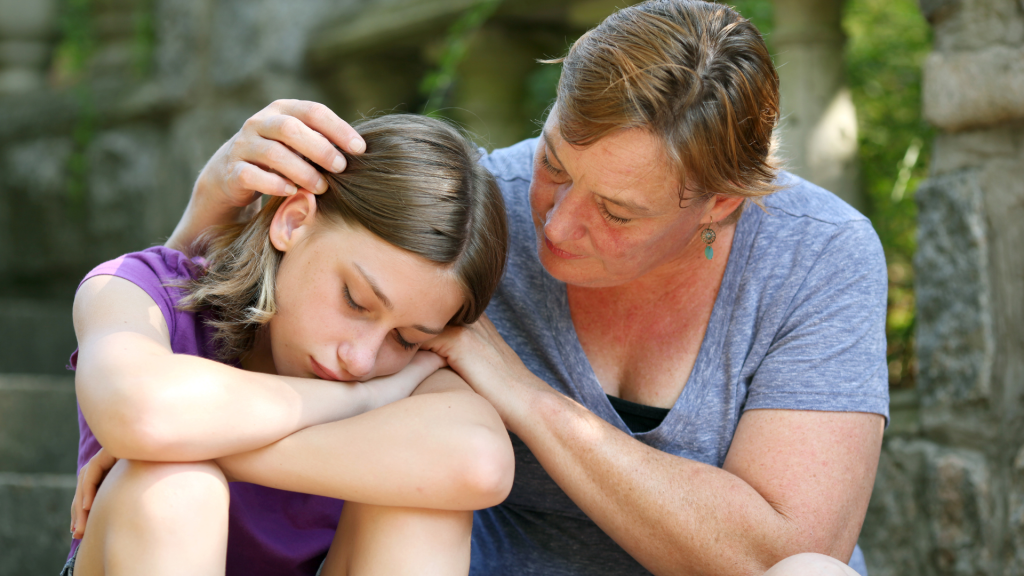How To Protect Your Child’s Emotional And Mental Well-being

Trigger warning – this blog contains mention of self-harm and suicidal ideation; reader discretion is advised.
My children’s teenage years were not easy (for them and for me). I have a fairly good memory of what it was like to be a teen, and I knew from speaking to friends and family who had teens that it was meant to be rough. But I had no idea.
As my children advanced into their teen years, they started having panic attacks and night terrors. I felt so helpless as they spiralled into depression, eating disorders and self-harm. I was not prepared for any of it. Man, it was hard!
We sought support from counsellors, doctors and psychologists. No one had any answers.
“Am I just a terrible mother?” I wondered.
It certainly felt like I was, and it was something that was hinted at more than once by medical professionals who remarked on my children’s levels of trauma.
Nothing was helping.
In fact, the weekly CBT therapy sessions and the high doses of anxiety medications and antidepressants just seemed to make things worse.
Then one morning, the unthinkable happened: one of my children took an overdose and spent a week in the hospital.
The Diagnosis That Changed Everything
We were a family in crisis.
Our world contracted. I put my successful career as a coach and professional development facilitator in the ECE sector on indefinite hold to focus on my family. We felt so isolated as the people in our support circle struggled to relate to what we were going through.
Thinking back to these impossible days, I recall the amount of energy it took to just get simply get out of bed and make it through the next minute, ten minutes, hour, 24 hours…
And then we got the diagnosis that changed everything. Our children were autistic.
“How”, you may ask, “did you not know this sooner?”.
You see, my children were born female. This means that they are one of the hundreds of thousands of girls, women and gender-diverse individuals who go undiagnosed as autistic. It turns out that until a couple of years ago, the diagnostic criteria did not even consider them.
I, as it turns out, am autistic too, and so familial blindness to autistic traits made it difficult for me to identify their traits as ‘unusual to the norm’.
Then came the biggest realisation: what they were struggling with, and why conventional treatments were not working, was autistic burnout.
What Is Autistic Burnout?
Autistic burnout is a very real and serious condition that can affect all autistic children, teenagers and adults. This chronic condition can cause extreme exhaustion, loss of executive functioning and social skills and an increased risk for depression, anxiety, self-harm and suicidal ideation.
Raymaker describes Autistic Burnout as;
A state of pervasive exhaustion, loss of function, increase in Autistic traits, and withdrawal from life that results from continuously expending more resources than one has coping with activities and environments ill-suited to one’s abilities and needs.In other words, Autistic Burnout is the result of being asked to continuously do more than one is capable of without sufficient means for recovery.
Raymaker 2020
Neuroscience research suggests that autistic burnout affects the brain of an autistic person in the same way a traumatic brain injury (e.g. a concussion or a TBI) affects the brain of a neurotypical person.
All autistic people are at risk for developing autistic burnout (even little children). However, the risk of developing autistic burnout is increased significantly if you are undiagnosed, high-masking, PDA, neurocomplex, gender diverse, or going through a big life transition.
In our case, late diagnosed, high masking AFABS, navigating the tricky adolescent transition between a teenager and a young adult.
Are you concerned that your child may be in burnout? Download my Free Burnout Signs Checklist

Why The Adolescent Years Are A Higher Risk For Developing Autistic Burnout
Autistic individuals are at risk of developing burnout at all ages and stages of life.
The adolescent years are a time of increasingly high demands, both internally and externally, for an autistic child. It is also a time of reduced internal resources.
Internal Demands
We know from neuroscience that the teenage brain goes through massive restructuring and pruning during the adolescent years and that the prefrontal cortex goes offline.
This means that our teens experience reduced executive functioning and emotional regulation skills and increased impulsivity.
Our teenagers are experiencing significant changes in their bodies as their reproductive systems come online and their hormones can be all over the place, which can impact mood and capacity. Autistic teens are also at risk for developing epilepsy.
For autistic girls and AFA,B menstruation can take up a lot of executive functioning. Autistic girls are also more affected by painful periods, endometriosis, PMS, and PMDD (Premenstrual Dysphoric Disorder). PMDD is a condition similar to PMS but more intense and can lead to increased irritability, depression and even suicidal ideation one to two weeks before the period starts.
Adolescence is a time when our children start to question their place in the world. They are discovering who they are as an individual and have a strong internal drive to separate from their parents, but this can cause a lot of confusing feelings. This can feel especially worrying for an autistic teen who may have a strong need for predictability.
Our teens are also discovering who they are as sexual beings. There is a large intersection between being autistic and being part of the LGBTQ+ community; this could be conflicting for the young person and cause conflict in their families. Many autistic teens identify as non-binary or transgender, which can lead to gender dysphoria and contribute to burnout.
Are You Concerned That Your Child May Be Experiencing Autistic Burnout? My parent membership could be the right next step for you to access resources and a community to support you and your family.

Increased External Demands
The teen years are a time of extremely high external demands. This is a time in your child’s life when they are generally transitioning from intermediate (middle school) to high school.
This places a huge load on our children’s executive functioning skills at a time when they are significantly diminished.
Some of this load includes:
- Increased workload.
- Keeping track of the timetable, where everything is, what books are needed, assessment due dates, exams, etc.
- Different teachers for each subject (differing teaching styles and expectations).
- Pressure from parents and teachers to ‘do well’.
- Decisions about future career path.
- Pressure to fit in socially – more complex social structure and relationships. More complex masking.
The Two Types of Autistic Burnout
When we think about autistic burnout, we generally think about acute burnout. However, there is another type of burnout that we as parents need to be aware of. This is the daily autistic burnout or ‘constant low-level burnout’ as explored in the AASPIRE Autistic Burnout study by Christian Maslach and Michael Lieter (2007).
This is caused by the daily social and sensory demands outweighing our child’s capacity to manage, and is often seen with children as presented in the typical ‘after-school meltdown’ or ‘coke bottle’ effect.
What typically happens is that our autistic child’s nervous system is in a state of constant arousal throughout the school day, which often requires a huge amount of energy to mask to appear ‘normal’ and to ‘keep it together’ to meet expectations. Their nervous system’s threat response is constantly activated and ‘shaken up’ like a bottle of fizzy drink over and over throughout the day.

When they get home and are in a place that they perceive as a place of safety, the ‘lid comes off,‘ leading to what we as parents see as a meltdown.
As you can imagine, this puts a huge strain on our child’s nervous system and, over time, can lead to the second type of burnout – acute autistic burnout.
Acute Autistic Burnout
Acute autistic burnout is a chronic and debilitating condition that leads to extreme exhaustion and loss of social and executive functioning skills. This usually requires an autistic person to remove all stress from their life, including their usual daily routines, going to school, and extra-curricular and social activities. It is a very serious condition and your child with need your support to help them recover.
Signs That Your Child May Be Experiencing Burnout
Here are some of the common signs that your child may be experiencing autistic burnout:
- Your teen may experience regression in skills – such as reduced cognition, executive function, memory, speech/communication, ability to cope, and ability to do things they once could do.
- They may need increased reassurance from a parent, become tearful, clingy or have trouble communicating how they are feeling.
- You may notice a difference in their mood. They have little or low motivation, chronic exhaustion, low mood, more frequent meltdowns/shutdowns, increased self-harming, suicidal ideation or attempts.
- Your child may lose the ability to mask and may appear ‘more autistic’ with increased stimming, etc. They may lose the ability to speak.
- They try to control the environment through rigid routines.
- You may notice that they have increased sensitivity to sensory stimuli.
- Your child may experience a reduced ability to tolerate social overload.
- They may withdraw socially or struggle to attend school or engage in learning.
- Your child may lose interest in special interests.
- You may notice changes to their sleep patterns with more disrupted sleep. They may be sleeping less due to increased anxiety, or alternatively, they may shut down and just want to sleep all the time.
- Changes in diet and eating habits are also common. Your child may want to eat a more restricted diet to try and keep some feeling of ‘control’, autonomy and predictability.
- Your child may not respond to ‘traditional’ treatments for depression or anxiety.
Important: This is not an exhaustive list. Each autistic person is unique. If you are concerned, please seek support from a neuro-affirming medical professional.
Are You Concerned That Your Child May Be Experiencing Autistic Burnout? Check out the From Burnout to Balance Membership to access resources and a community to support you and your family.

Ways That You Can Protect Your Child From Burnout
Here are five ways that you can protect your child from burnout:
Pay Attention To Afterschool Meltdowns
If your child is having regular afterschool meltdowns or shutdowns, this could be an indicator that your child is experiencing daily autistic burnout. Daily autistic burnout can lead to acute burnout and is a warning sign that something in your child or teen’s environment needs to change.
The After-School Decompress
One way that you can mitigate the demands of your child’s school day is through the after-school decompress.
Here’s how we do it in our house:
- We have a predictable afterschool routine with little to no demands directly after school – I don’t require my child to pack away their bag or do chores or homework. I don’t ask them about their day unless they volunteer the information.
- I prepare them a snack with ‘safe’ foods which they eat while engaging with their special interest for 30 minutes to an hour before they start their homework.
We also have ‘work-from-home days’ or low-demand days when I notice meltdowns or shutdowns are increasing.

S.P.E.N.D
If you have noticed that your child’s behaviour is becoming increasingly dysregulated, there are five areas in their life to pay attention to protect their mental and emotional wellbeing.
The acronym for this is S.P.E.N.D
S stands for Space. It considers how much space your child has to be their authentic autistic self.
For example, is there enough space for them to engage with their special interest? Is it safe for them to unmask?
P stands for Predictability. It considers how predictable your child’s life is.
For example, can they predict the people in their lives and their reactions? Is there a familiar rhythm to their day with predictable, flexible routines? Do they have enough time to process transitions or any changes that may occur?
E stands for Environment. It considers your child’s sensory environment.
For example, can they stim or meet their sensory-seeking needs? Or is there too much sensory overwhelm and sensory stimulation that needs to be reduced?
N stands for Needs. It considers how well your child’s needs are being met.
For example, are they getting enough sleep, nutrition and hydration? Do they have enough time to decompress after busy, socially draining situations? Are they unwell? Can they tell if they are unwell? Do they feel comfortable asking for help? Do they have a person they can co-regulate with?
D stands for Demands. It considers how many demands (real or perceived) there are in your child’s day.
How many real and perceived demands are there in my child’s day? How many transitions are there that they have to navigate? Do they have enough time and support to navigate these transitions? Can we remove some of these demands or transitions?
Some important considerations for parents are: Where can we practice radical acceptance, reduce demands and increase connection with our children?
I would like to acknowledge @anautisticguide for this helpful framework.
Low Demand Parenting
Low-demand parenting is a style of parenting where we remove as many demands from our parenting as possible.
This could include:
- Removing all stressors from our child’s life.
- Practising radical acceptance and prioritising only essential tasks and requests of your child.
- Using declarative language.
- Accommodation for your child’s needs.
Adopting a low-demand parenting approach reduces the likelihood of reoccurring burnout and also the severity of potential mental health issues. If your child is experiencing Autistic Burnout this approach may help to reduce the length and severity of their burnout.
Autistic Realms
Additional Support and Resources:
If you are wondering if your child is in Autistic Burnout and would like some clarity, take my FREE Mini-Course: Burnout 101-Understanding and Recognising Neurodivergent Burnout.
Meet The Person Who Wrote This Blog

Tanya Valentin is an AuDHD person, mum of three, family coach, author and podcaster.
She specialises in guiding parents of Autistic & ADHD children and teens through burnout recovery with empathy & support.
She is the founder of From Burnout To Balance and the host of the podcast with the same name.
Need support?
Need support? Book a FREE 15-minute call with Tanya

1 Comment on Understanding Autistic Burnout